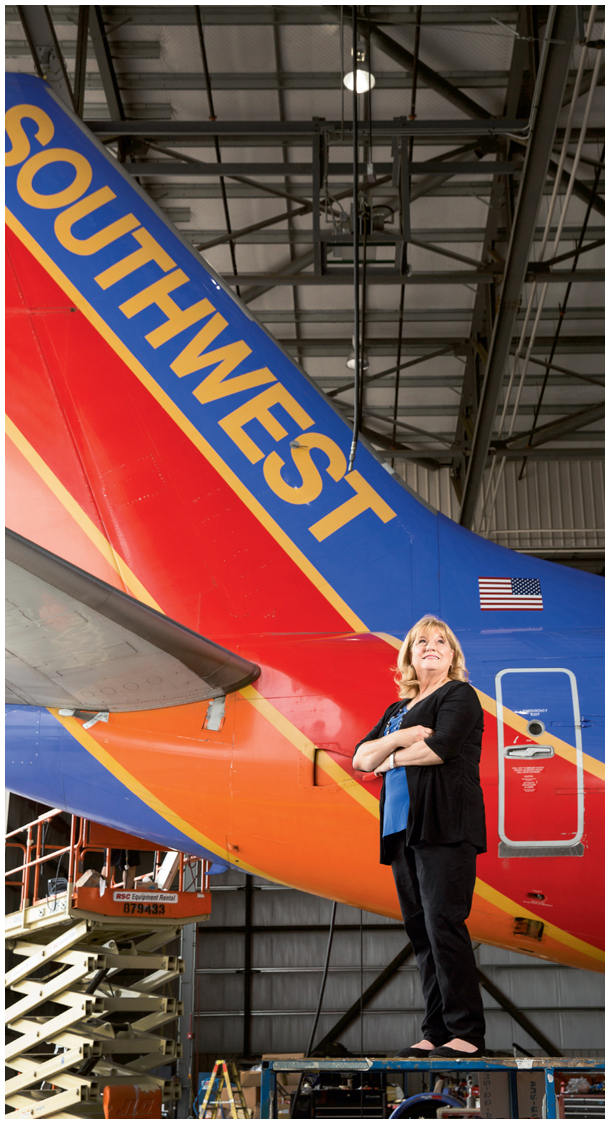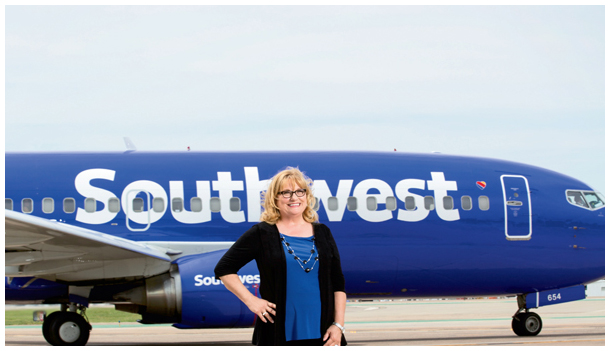When you ask Patti Colwell, workers' compensation program manager for Southwest Airlines (SWA), what she likes most about her job, her response is simple: “I can't imagine doing anything else.”
One doesn't necessarily have to love managing a workers' comp program in order to do the job well (after all, not everyone does), but Colwell's passion is sincere as she enthusiastically discusses her program.
Related: Winner's circle: Maximum overhaul
Colwell and her program receive complete support from Southwest's leadership, she says, and the workers' comp team has a strong business partnership with its service providers—one of the things of which she's most proud. She stresses that all parties work hard to ensure that everyone involved in the airline's WC program takes an ownership interest and responsibility for outcomes. Which is essential, because SWA has about 48,000 employees spread over six international and 94 domestic destinations.
“We're here to serve the employees,” she says. “We do the best we can to mitigate difficult situations and make them as right as we can make them.”
Southwest's corporate culture places great emphasis on customer service, and the workers' comp team under Colwell's leadership embraces a quite similar philosophy by putting the employee first. Her team, along with the corporate safety and security department of which they're a part, starts from the date of hire to educate employees on the requirements of their jobs and how to perform those duties safely and successfully.
The most at-risk employees are the baggage handlers—which SWA calls “ramp agents”—and provisioning agents who load the plane with baggage, food and drinks, paper goods and snacks in addition to cargo. “I have been in the belly of the airplane, with knee pads and stacked bags, worked the customer service positions, opened the emergency exit door and deployed the slide—and even evacuated during a simulated emergency,” says Colwell. “We provide safety programs to highlight safe-lifting techniques and the importance of stretching and bending before starting work. We also teach them how to properly climb and reach.”
 The airline also invites physicians and other healthcare professionals to tour its operations areas. “Unless you understand the way our employees have to perform their jobs, you can't really understand the physical stress on their bodies,” she says.
The airline also invites physicians and other healthcare professionals to tour its operations areas. “Unless you understand the way our employees have to perform their jobs, you can't really understand the physical stress on their bodies,” she says.
Colwell has had orthopedic specialists get inside the bins of planes on their hands and knees to see what ramp agents have to do every day, for example. They simulate stacking bags from floor to ceiling, including overhead lifting, so they understand how back injuries happen and what muscles are involved. Healthcare providers have found the visits beneficial in structuring treatment plans. “When employees get the proper treatment faster, they can heal and we can get them back to work faster, too,” she notes.
Related: Winner's circle: Serious fun
Southwest's return-to-work program was recently restructured. Previously, modified duty was voluntary; employees would receive full salary continuation benefits even if they declined modified duty. Under the restructured program, modified duty is offered to all injured workers who aren't deemed temporarily completely disabled. For non-union and some collectively bargained work groups, there are now financial consequences to declining modified-duty work.
It's still early, but Colwell says she's seeing great success. “Studies show that employees heal faster if they're doing some sort of meaningful work,” she explains, “and we've seen that come to fruition. We're seeing employees released to full duty or regular duty jobs more quickly in those work groups than under the voluntary program.”
Colwell is especially proud of how well Southwest compares to the airline industry overall. Of the seven major carriers that met to do some benchmarking on WC costs, in the past six years SWA's average incurred and average paid-on-indemnity claims is about 40% less than other airline carriers; its litigation rate is about 40% lower than the other carriers; and its average lost work days per claim is about 15 days fewer than other carriers.
Colwell has been told that the airline's WC approach is much different than that taken by many of its competitors. “Our TPA, managed-care services and pharmacy benefit managers all work together,” she explains. The workers' comp claims data is integrated so that Southwest and its service providers are sure they're implementing the best programs to serve employees, help them heal and get them back to work in the most cost-effective way possible.
Although it's typical to have regular claim reviews, Colwell and her team approach the process with collaboration in mind: Southwest gathers claims adjusters and supervisors, the person on the workers' comp team who is responsible for that particular area of the company, the airline's workers' comp attorney, outside attorneys, the dedicated nurse supervisor, the managed care and pharmacy benefit managers, and occasionally leaders from the employee's local work location if questions are raised about specific claims.
 “We talk about those claims and what it takes to get that employee the necessary treatment, what are the obstacles, what do we have to do to get that person well and back to work,” she says. “Of course we're interested in how much it's going to cost, but our primary focus is the injured employee.”
“We talk about those claims and what it takes to get that employee the necessary treatment, what are the obstacles, what do we have to do to get that person well and back to work,” she says. “Of course we're interested in how much it's going to cost, but our primary focus is the injured employee.”
If an employee injures his back, for example, many companies and doctors might urge conservative treatment and a wait-and-see approach. But if a Southwest worker injures his back and an MRI would help diagnose the injury sooner, then the airline authorizes the MRI early on. She'd rather do that than wait six weeks and find out that the employee needs surgery, which they would have learned earlier by authorizing the MRI immediately.
Colwell's advice for her fellow workers' comp managers is succinct: Practice the golden rule—with employees, vendors, leadership and everyone you deal with.
“I believe this is an area where we can still make a difference,” she adds. “There's always something that can be done better to improve the program and something that can be done better to help our employees. I strive for that every day.”
Related: Best of the best: The winners of NU's Excellence in Workers' Comp Risk Management Award
Want to continue reading?
Become a Free PropertyCasualty360 Digital Reader
Your access to unlimited PropertyCasualty360 content isn’t changing.
Once you are an ALM digital member, you’ll receive:
- Breaking insurance news and analysis, on-site and via our newsletters and custom alerts
- Weekly Insurance Speak podcast featuring exclusive interviews with industry leaders
- Educational webcasts, white papers, and ebooks from industry thought leaders
- Critical converage of the employee benefits and financial advisory markets on our other ALM sites, BenefitsPRO and ThinkAdvisor
Already have an account? Sign In Now
© 2025 ALM Global, LLC, All Rights Reserved. Request academic re-use from www.copyright.com. All other uses, submit a request to [email protected]. For more information visit Asset & Logo Licensing.








